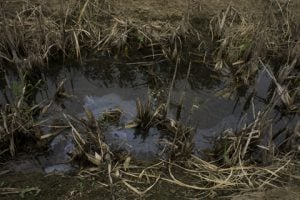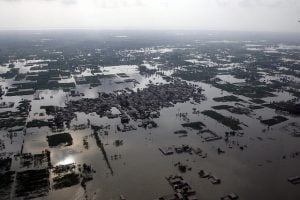JANUARY
Soil pollution was the first major environmental story to generate rolling coverage in 2014 as Wang Shiyuan, the vice-minister of land and resources, told a news briefing in late December that around 3.33 million hectares of China’s farmland was too polluted to grow crops.
China’s first legally binding regulations for reducing PM2.5 levels were approved by Beijing’s municipal congress. Fang Li, deputy head of Beijing’s environmental authority, told China’s state news agency Xinhua that the regulation would be Beijing’s first effort to set a target to curb the city’s total pollutant emissions.
The Chinese government destroyed 6.15 tonnes of seized elephant ivory, suggesting that China is firmly behind international action to address the illegal ivory trade. The move was controversial, as many people argued that the action had sent prices higher (thus increasing the incentives and rewards for poachers).
Meanwhile, a factory in China's Zhejiang province that processed more than 600 endangered whale sharks a year to be sold for food, shark oil and leather, was uncovered by NGO WildLifeRisk.
FEBRUARY
Chronic air pollution returned to dominate the headlines, with Beijing's city government attacked by state media for failing to react to the smog that returned to the capital between February 14 and 16. One man from smog-enshrouded Hebei province decided to take the local environmental authority to court for failing to control air pollution. Li Guixin sued the municipal environmental protection bureau for 10,000 yuan to compensate for the money he had spent on an air filter and indoor treadmill.
MARCH
As choking smog continued to cloak Chinese cities, the issue was a major talking point at the ‘Lianghui’ which are the annual meetings of the country’s legislature. Chinese premier Li Keqiang told party members that China’s ‘war on air pollution’ is a war on inefficient and unsustainable growth, and acknowledged that poor air quality had become an increasing concern for the country’s citizens. In his closing speech to the National People’s Congress in Beijing, Li said: “We have declared war on smog because this is what society cares about. The first thing most people do these days is check PM 2.5 levels on their phone."
Away from the Lianghui discussions in Beijing, China’s environmental record outside its borders came under renewed scrutiny as Cambodian villagers brought Sinohydro’s construction of a dam on a major Mekong tributary to a standstill. The action of villagers in Cambodia was just the latest of controversies surrounding Sinohydro, the world’s leading dam developer.
And corporate China’s growing footprint in Latin America also became an in increasingly big story during 2014, with Aluminium Corp of China (Chalco) in March coming under the microscope for a toxic leak in Peru which prompted the authorities to order a halt to production.
APRIL
Springtime saw the passing of an environmental protection law in China, which stirred a great controversy during its amendment process. The updated law was viewed as making progress in the area of public interest litigation and strengthened the legislative tools to punish polluters. But observers said the new law failed to solve one of the major problems relating to environmental laws in China – how to compel local officials to enforce the rules effectively. Other commentators worried that China’s inexperienced courts would struggle to cope with complex environmental cases.
A tendering process for contracts to oversee the construction of mines and civil engineering works at Duosuogongma was launched, confirming that the Sanheyuan Reserve, designated a protected area by the Qinghai government in 2005, had been shrunk to make way for mining work.
The growing impact of China’s ‘citizen journalists’ in exposing pollution and taking action against wrongdoers was recognised by the China Environmental Press Awards. Wang Chunsheng, a forty-year old citizen of Shouguang in eastern China’s Shandong province, uncovered the dreadful environmental record of a local chemical company, Lianmeng Chemical Group. The company responsible was eventually punished by the provincial environmental authorities.
China’s Ministry of Environmental Protection handed out biggest fines to date – 19 firms fined 410 million yuan for not properly using sulphur scrubbing equipment, including power giants Huadian and Datang.
An annual dog-meat festival in Yulin, Guangxi Province, drew even stronger ire from animal rights activists, pitting them against locals who maintained their right to uphold “tradition”, although the 'festival' has only been held since 2009.
Rubbish, and how to deal with it, was a running theme through the summer as China made its biggest overseas environmental acquisition to date, the 5.1 bn yuan purchase of New Zealand waste-management firm Transpacific New Zealand.
China, along with the four other country that makes up the BRICS bloc of large non OECD countries – Brazil, Russia, India, and South Africa – came together at their annual summit to announce the establishment of a new, hotly anticipated development bank. The BRICS bank, a multilateral initiative led entirely led by Southern countries, was touted by some as a financial competitor to the Western dominated World Bank and IMF, but others feel the main motivation is political.
AUGUST
Stronger signs emerged that China is switching from its blind pursuit of economic growth at all costs towards measures that encourage better quality of life. by the middle of 2014, more than 70 Chinese smaller cities and counties dropped gross domestic product as a performance metric for government officials, in an effort to shift the focus to environmental protection and reducing poverty. The move followed a directive issued by top leaders last year.
A major earthquake in Yunnan is linked to dam building by geologist Yang Yong.
Concerns about the environmental impact of huge hydroelectric projects are stoked up even further as a landslide wipes out a dam in the Three Gorges region.
Chinese internet tycoon Jack Ma, who is also chairman of the Board for the Nature Conservancy's China Program, comes under fire because he took part in a hunting trip in Scotland. Although Scottish conservationists pointed out on chinadialogue that the subject was more complicated than many assumed.
Villagers from the township of Gangkou in Jiangxi province, south-east China, smashed up a new lead recycling plant which was due to begin operating after 200 children found to have excess levels of the poisonous metal in their blood.
SEPTEMBER
UN secretary-general Ban Ki-moon hosts a summit of world leaders in New York to discuss action on climate change, while demonstrations are held globally to put pressure on world leaders to slash carbon emissions, but Xi Jinping fails to attend summit.
The New Climate Economy report reveals that deaths and illness caused by coal-driven air pollution could be costing China 13% of GDP.
OCTOBER
Following the Fourth Plenum of China’s Communist Party, China legal expert Cao Mingde tells chindialogue that the environmental sector could act as a test-bed for better application of law.
A draft discussion document on proposals to change national parks system is circulated as China’s central government embarks on reforms to the way major tourist attractions are run.
NOVEMBER
In the run-up to climate change talks in Lima, China and the US make a landmark joint announcement on 2030 targets and the use of coal. The move is widely seen as an attempt to pave the way for an agreement at crunch UN climate talks in Paris at the end of 2015, and to encourage trade in green technologies between the two countries. But commentators point out that there may be plenty of obstacles in both countries towards a low carbon energy revolution.
DECEMBER
UN climate talks in Lima end without making progress on most of the major issues, raising fears that negotiating an ambitious agreement in Paris may be out of reach. The one area of limited agreement in the talks – through which all major emitters for the first time agreed to submit plans on how they will cut emissions – was reported to be the result of a last minute initiative from China and US to salvage some progress from the meeting.







